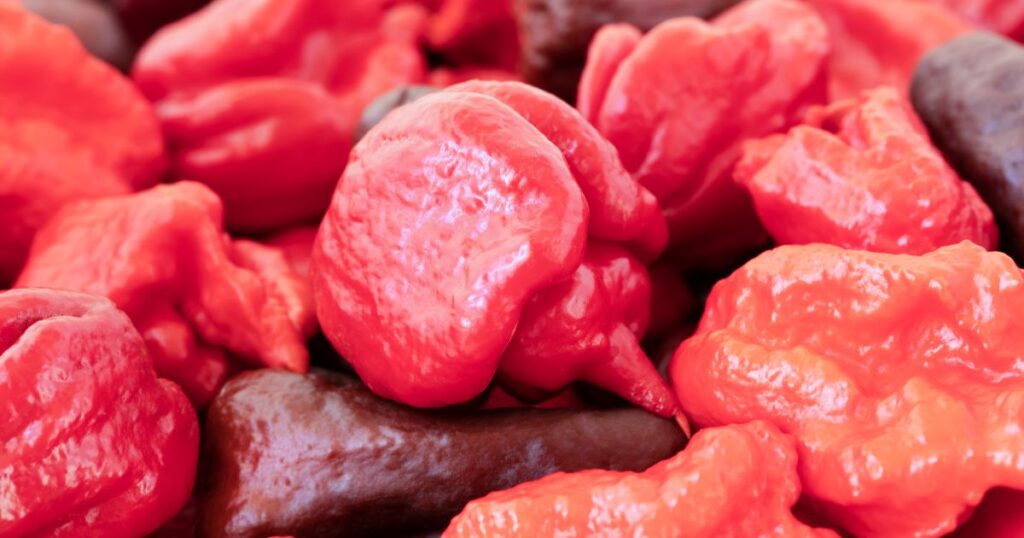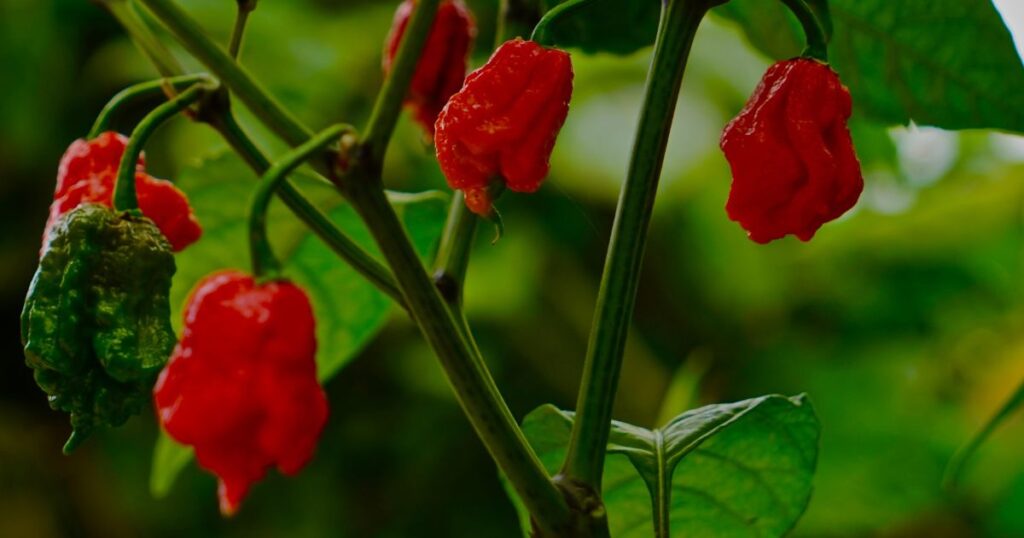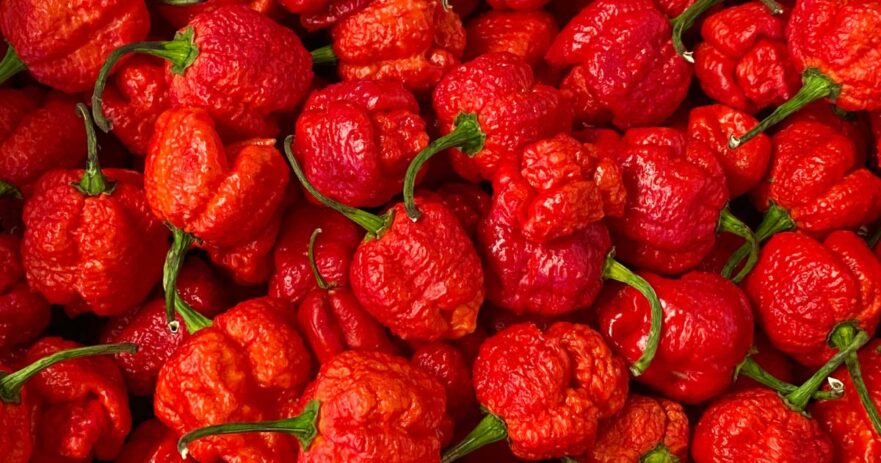In this article about Carolina Reaper:
🗺️ Origin and history | 🌶️ Uses | ✨ Appearance and taste | 🌶️ Types | 🧑🌾 Growing – gardening | 👨🍳 Cooking – recipes | 🛒 Where to buy | 🫙 How to store | 👨⚕️ Health benefits | 🌶️ Alternatives and substitutes | ❓ Frequently asked questions
What is Carolina Reaper Pepper?
The Carolina Reaper pepper is a super-hot chili pepper recognized as one of the world’s hottest peppers. It is a hybrid variety developed by crossing a Pakistani Naga pepper with a Red Habanero. The Carolina Reaper was created by Ed Currie, the founder of PuckerButt Pepper Company; he developed it in his greenhouse in South Carolina, USA.
The Carolina Reaper pepper boasts an impressive level of heat. Its distinct appearance, characterized by a bright red color and a gnarled, stinger-like tail, sets it apart from other chili peppers. A fruity, slightly sweet flavor complements the Carolina Reaper’s extreme heat. It is thus commonly used in hot sauces, spice blends, and other fiery dishes. However, due to its intense heat, handling and consuming the Carolina Reaper with caution is essential; it can cause significant discomfort or even pain when ingested or touched.
| Carolina reaper pepper | |
| SHU | 1,400,000 - 2,200,000 |
| Median SHU | 1,800,000 |
| Flavor | Fruity and sweet, with an intense and lasting heat |
| Species | Capsicum chinense, Hybrid (Naga pepper x Habanero) |
| Origin | South Carolina, USA |
| Uses | Hot sauces, salsas, chili, marinades, etc. |
Are Carolina Reapers spicy? How hot are they?
Carolina Reaper scoville: 1,400,000 to 2,200,000 SHU
Carolina Reaper peppers have extraordinary spiciness, with Scoville ratings ranging from 1,400,000 to 2,200,000 units. For comparison, jalapeño peppers, considered moderately spicy, only reach 2,500 to 8,000 Scoville units. The Carolina Reaper is exponentially hotter than other commonly used chili peppers.
As you venture into the world of super-hot chili peppers, you must be cautious when handling or consuming Carolina Reapers. Their intense heat can cause significant discomfort or pain when ingested or touched. However, for those who crave extreme spice and are well-versed in consuming hot chilies, the Carolina Reaper offers a unique combination of intense heat and fruity, slightly sweet flavor.
🗺️ ORIGIN AND HISTORY
Where do Carolina Reaper peppers come from?
The Carolina Reaper pepper, currently recognized as one of the world’s hottest peppers, was initially cultivated in South Carolina by Ed Currie, the founder of the PuckerButt Pepper Company. Currie’s quest for an incredibly spicy pepper led him to develop this scorching variety by crossbreeding the Pakistani Naga Viper with the Red Habanero from St. Vincent’s Island. As a result, Ed created the Carolina Reaper pepper variety to push the boundaries of heat and flavor, resulting intense spiciness and a unique taste profile.
The Guinness World Records organization officially recognized the Carolina Reaper pepper as the world’s hottest chili pepper in 2017, dethroning the former titleholder, the Trinidad Scorpion Butch T. According to tests carried out by Winthrop University in South Carolina, the official 2017 Guinness World Record tested batch average heat level was 1,641,183 SHU. The spiciest individual pepper in the batch registered a staggering 2,200,000 SHU. The Carolina Reaper’s exceptional heat and distinctive flavor have attracted loyal spice enthusiasts and a culinary daredevil fan base.
🌶️ USES
What are Carolina Reaper peppers good for? How to use them?
With their extreme heat and unique flavor, Carolina Reaper peppers can be incorporated into various culinary creations. The intense spiciness of these peppers also lends itself well to a range of bold and daring products.
One such product is Carolina Reaper powder, which can add a fiery kick to dishes like chili, soups, or stews. A little goes a long way, so be cautious when using this potent powder. Carolina Reaper pepper beef jerky is another example of the pepper’s heat added to a tasty snack, providing a spicy twist on a classic favorite.
Carolina Reaper pepper cheese puffs and Carolina Reaper pepper Cheetos are perfect options for those who love spicy snacks. These spicy delights bring a new level of heat to popular foods, challenging the taste buds of even the most dedicated spice enthusiasts.
In addition to snack foods, Carolina Reaper chili flakes and Carolina Reaper chili oil enhance the flavor and heat of various dishes. Sprinkle chili flakes on pizza, pasta, or grilled vegetables, or drizzle the chili oil on salads, stir-fries, or roasted meats.
Carolina Reaper pepper sauce is another versatile product for tacos, burgers, or dipping sauces. Its intense heat adds an adventurous twist to various dishes.
Carolina Reaper pepper spray, primarily intended for self-defense, is a non-culinary application of this powerful pepper. Creating the spray at home is possible, but it is crucial to exercise extreme caution during the process and when handling the finished product due to its potency.
Incorporating Carolina Reaper peppers into these products and dishes showcases the versatility of this fiery chili. Whether in a powder, sauce, or snack food, the Carolina Reaper pepper elevates the heat and adds a unique flavor that challenges and excites the palates of those who dare to indulge.
✨ APPEARANCE AND TASTE
What does a Carolina Reaper pepper look like?
Carolina Reaper peppers have a distinctive appearance, characterized by their small, wrinkled, and gnarled exterior. The peppers are typically 1-3 inches long and 1-2 inches wide, with a pointed tail resembling a scorpion’s stinger. They exhibit a vibrant range of colors when fully mature, transitioning from green to orange or bright red. The Carolina Reaper’s unique appearance and texture set it apart from other peppers, making it recognizable as one of the world’s hottest peppers.
What do Carolina Reaper peppers taste like?
Carolina Reaper peppers pack an intense heat overwhelming for those unaccustomed to consuming extremely spicy foods. Beyond their scorching heat, Carolina Reapers exhibit a fruity, sweet undertone that can be detected before the spiciness overpowers it. The flavor profile complexity makes them a popular choice among chili enthusiasts who appreciate the balance of sweetness and fiery heat. However, it’s essential to approach Carolina Reapers cautiously, as their intensity can be overpowering and lead to discomfort for those unprepared for their extreme spiciness.

🌶️ TYPES
What are the different types of carolina reaper?
Carolina Reaper peppers come in different colors, with each variation presenting a unique appearance and subtle differences in taste. We explore two notable types: the Yellow and Green Carolina Reaper.
The Yellow Carolina Reaper, also known as the Yellow Reaper, is a vibrant yellow variant. In addition, the Yellow Reaper has a fruity, citrusy flavor profile, making it an excellent choice for those seeking to add a burst of color and intense heat to their cuisine.
Conversely, Green Carolina Reapers are unripe versions of the more mature and colorful Carolina Reaper. They possess a somewhat milder heat compared to their ripe counterparts, as well as a grassier, less sweet flavor. Therefore, Green Carolina Reapers can be used in various dishes where a slightly toned-down heat and a more herbaceous flavor are desired.
While the original Red Carolina Reaper remains the most iconic and well-known type, the Yellow and Green Carolina Reapers offer intriguing alternatives for experimenting with heat and flavor levels. Handling and consuming Carolina Reaper peppers with caution is crucial regardless of color. Their intense heat can be overwhelming and lead to discomfort for those unprepared for their spiciness.
🧑🌾 GROWING – GARDENING
How to grow Carolina Reapers?
Carolina Reaper peppers present an enticing challenge for home gardeners interested in cultivating an exceptionally spicy chili pepper. These peppers thrive in warm, sunny climates, ideal for areas with extended, hot growing seasons. Carolina Reaper peppers can be grown in containers or planted directly into well-drained soil, as long as there is regular watering, which is vital for their successful development. Consistent fertilization throughout the growing period can also ensure a generous harvest.
When to pick Carolina Reaper peppers?
When it comes to harvesting Carolina Reaper peppers, timing is key. These peppers generally require between 90 to 100 days to reach full maturity. Therefore, the optimal time to pick them is when they have achieved their deep red hue and developed a unique, wrinkled appearance. Exercising caution during harvest is important due to the peppers’ extreme heat.

👨🍳 COOKING – RECIPES
Cooking / Recipe ideas for Carolina Reaper
Carolina Reaper peppers can add a fiery kick to various dishes, but use them sparingly due to their extreme heat. One way to incorporate Carolina Reaper peppers into your cooking is by making Carolina Reaper pepper jelly. Also, this sweet and spicy condiment pairs well with cream cheese and crackers or as a glaze for grilled meats. To make the jelly, combine chopped Carolina Reaper peppers with sugar, vinegar, and pectin, and cook until they reach the desired consistency. Be sure to wear gloves and take precautions when handling these potent peppers.
Another popular option for using Carolina Reaper peppers is to create a homemade Carolina Reaper pepper sauce. This versatile sauce can spice up dishes such as tacos and wings or even as a fiery addition to mac and cheese. Blend Carolina Reaper peppers with tomatoes, garlic, onions, vinegar, and spices for a bold and fiery sauce. Remember, a little goes a long way, so adjust the heat level to your preference.
Carolina Reaper chili flakes and oil can also be incorporated into your cooking. Sprinkle the flakes onto pizza, pasta, or popcorn for an extra kick, or drizzle the oil over roasted vegetables or stir-fries for a spicy twist. Remember that Carolina Reaper peppers are extremely hot, so start with a minimal amount and adjust according to taste.
Always remember that less is more when using Carolina Reaper peppers. Their intense heat can overpower a dish, so use them sparingly and adjust according to your heat tolerance. However, with careful experimentation, Carolina Reaper peppers add a new dimension of spice and flavor to your favorite recipes.
🛒 WHERE TO BUY
Where can I buy Carolina Reapers?
Known for their extreme heat, Carolina Reaper peppers can be found at select grocery stores, particularly those that carry a wide range of chili peppers. If you cannot find them at your local store, try searching at specialty food stores, farmer’s markets, or ethnic markets that carry various hot peppers. Online shopping offers another option for purchasing Carolina Reaper peppers, with websites selling fresh, dried, or powdered forms and related products such as sauces and snacks.
When buying Carolina Reaper peppers, ensure they are vibrant in color and firm. Avoid peppers that are soft, wrinkled, or have blemishes, as these may indicate they are past their prime. If you’re interested in buying Carolina Reaper pepper products, such as Carolina Reaper pepper powder, sauces, or snacks, look for reputable brands that clearly label their ingredients and heat levels.
Where can I buy Carolina Reaper plants?
For gardening enthusiasts who want to grow their own Carolina Reaper pepper plants, check garden centers or nurseries specializing in vegetable plants. Online retailers also offer Carolina Reaper pepper plants, allowing you to receive them conveniently at your doorstep. Select sturdy stems, vibrant green leaves, and no wilting or discoloration when selecting plants.
Where can I buy Carolina Reaper seeds?
If you prefer to grow Carolina Reaper peppers from seeds, purchase them online or from garden centers. When planting Carolina Reaper pepper seeds, follow the instructions on the seed packet. Ensure they receive ample sunlight and well-drained soil for optimal growth.
🫙 HOW TO STORE
How do I store Carolina Reapers?
Fresh Carolina Reaper peppers can be stored in the refrigerator for up to two weeks to maintain their freshness. Then, place the peppers in a plastic bag or an airtight container and keep them in the crisper drawer of your refrigerator. This will help retain their unique texture and flavor.
Carolina Reaper peppers can also be preserved by drying or freezing. To dry the peppers, use a food dehydrator or hang them in a well-ventilated area with low humidity. Once fully dried, store the peppers in an airtight container and keep them in a cool, dark place for several months.
For those who have Carolina Reaper pepper products, such as sauces or powders, store them in a cool, dark place like a pantry or cupboard. It’s best to keep the sauces in their original bottles or transfer them to airtight containers, as well as ensure the lids are tightly sealed to maintain freshness and prevent any spoilage.
Can Carolina Reapers be frozen?
Yes, Carolina Reaper peppers can be frozen, too. To freeze them, wash the peppers thoroughly and remove the stems. Then, arrange the peppers in a single layer on a baking sheet and freeze them for a few hours. Once frozen, transfer the peppers to a resealable plastic bag or airtight container and store them in the freezer for up to six months. This method preserves their flavor and heat for later use.

❤️🩹 HEALTH BENEFITS
Are Carolina Reapers healthy?
While known for their extreme heat, Carolina Reaper peppers also provide various health benefits. These fiery peppers are abundant in vitamins A and C, essential in maintaining healthy skin, eyes, and immune system function. However, it’s worth noting that reaping these benefits may prove challenging due to the need to consume lots of the peppers. Nevertheless, for those who can tolerate the heat, these peppers offer a unique and beneficial addition to a balanced diet.
The capsaicin in Carolina Reaper peppers boasts various health-promoting properties, including anti-inflammatory and pain-relieving effects. In addition, this compound has also been linked to increased metabolic activity and weight loss.
However, some individuals may experience gastrointestinal discomfort, heartburn, or other digestive issues after consuming Carolina Reaper peppers due to their extreme spiciness. In such cases, limiting consumption, monitoring one’s tolerance levels, or avoiding them entirely to prevent adverse reactions is advisable. It’s important to remember that everyone’s tolerance for spicy foods varies, so take a cautious approach when introducing Carolina Reaper peppers into your diet to ensure a more enjoyable experience without any unwanted side effects.
🔄 ALTERNATIVES AND SUBSTITUTES
What’s a good Carolina Reaper alternative?
If you’re seeking a suitable alternative to Carolina Reaper peppers, several options exist. While still incredibly spicy, ghost peppers offer a milder heat than Carolina Reapers, with a SHU rating of approximately 855,000 to 1,041,427. Therefore, they are a fitting substitute when looking for a strong kick in your dishes without reaching the extreme spiciness of Carolina Reapers.
Another option is the Trinidad Moruga Scorpion, which provides a similar intensity with a SHU rating of around 1,200,000 to 2,009,231. This pepper works well in hot sauces, stews, and marinades where a potent heat and fruity flavor are sought after. However, remember that Trinidad Scorpion peppers are still among the world’s hottest chilies, so use them sparingly.
The habanero pepper is a good choice for those who prefer less heat but still want some spiciness. Although significantly milder than the Carolina Reaper, habaneros still pack a SHU rating of 100,000 to 350,000 with a fruity, tangy flavor that works well in various dishes. In addition, Habanero peppers are versatile and can be used in salsas, sauces, and marinades, providing a more manageable heat level while imparting a delicious taste.
How do you pronounce Carolina Reaper?
Carolina Reaper is pronounced kair-uh-LY-nuh REE-per.
🙋 FREQUENTLY ASKED QUESTIONS
FAQ about Carolina reaper pepper
Are Carolina Reaper peppers dangerous?
Carolina Reaper peppers are not inherently dangerous if consumed in moderation. However, they are extremely spicy, with Scoville Heat Units (SHU) of 1,400,000 to 2,200,000. Consuming large amounts or handling them without proper precautions can lead to severe discomfort, including skin, eye, or gastrointestinal irritation. Individuals sensitive to spicy foods or with pre-existing medical conditions should exercise caution when consuming Carolina Reaper peppers.
Can Carolina Reaper peppers kill you?
It is highly unlikely that Carolina Reaper peppers can kill you. However, excessive consumption may cause severe discomfort and temporary health issues, such as intense burning sensations, vomiting, and diarrhea. People with underlying health conditions, such as heart or gastrointestinal issues, should consult their doctor before consuming these spicy peppers.
What color are Carolina Reaper peppers?
Carolina Reaper peppers usually have a bright red color when fully ripe. However, they can also be yellow or green. The green Carolina Reapers are unripe, while the yellow ones are a different variety called Carolina Reaper Yellow.
What are the symptoms of Carolina Reaper‘s consumption?
The symptoms of Carolina Reaper refer to the effects experienced after consuming them. Common symptoms include intense burning sensations in the mouth, throat, and stomach, profuse sweating, tearing, and runny nose. Some people may also experience nausea, vomiting, diarrhea, and dizziness due to their extreme spiciness.
Are Carolina Reaper peppers illegal?
Carolina Reaper peppers are not illegal. They are cultivated and sold legally for consumption and use in various culinary applications. However, handling and consuming them responsibly is essential due to their extreme heat.
What should I do if Carolina Reaper pepper gets in my eye?
If you accidentally get Carolina Reaper pepper in your eye, immediately flush it with cool water for at least 15 minutes. Avoid rubbing your eye, as this can worsen irritation. If the burning sensation persists or increases, seek medical attention. To prevent eye contact, always wear gloves when handling Carolina Reaper peppers and wash your hands with soap thoroughly afterward.
